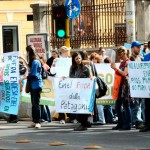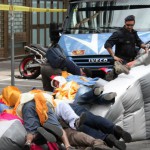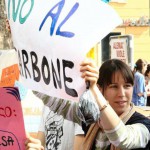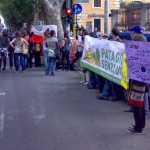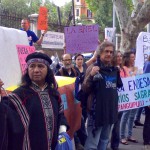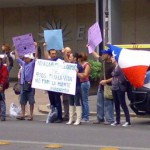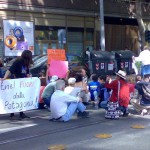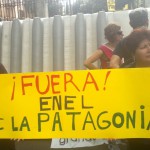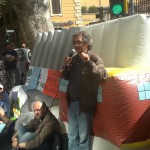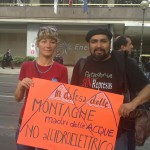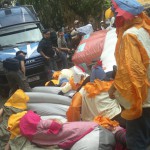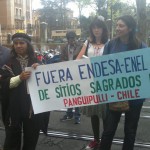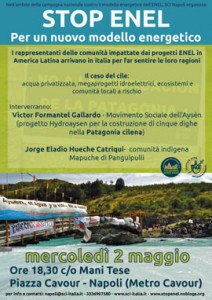ENEL es la más grande empresa eléctrica italiana y la segunda en Europa por capacidad instalada. En el 1999 fue privatizada y hoy es cotizada en la bolsa contando con 1.2 millones de accionistas. Una parte de la empresa sigue siendo pública ya que el 31% es propiedad del Ministerio de Economía y Finanzas, por lo tanto de los ciudadanos italianos.
Hoy en día ENEL opera en el sector de la energía eléctrica y del gas en 40 países. En el 2009 con la adquisición definitiva de la empresa eléctrica española ENDESA, Enel heredò las plantas y los proyectos en numerosos países de América Latina, proyectos acomunados por una evidente herencia colonial, que incluye legislaciones nacionales antidemocráticas y sistemas de evaluación ambiental claramente deficientes y sesgados hacia el sector corporativo, como demuestra la gravedad de los impactos socio-ambientales. La arrogancia de Enel se ha manifestado de manera brutal también en Italia, hacia los habitantes y los territorios que han sido involucrados por sus proyectos.
No obstante la imagen verde y de compromiso hacia la sustentabilidad que la transnacional italiana se apresura a comunicar a través de sus mensajes promocionales, la realidad es muy distinta. ENEL sigue construyendo centrales de carbón sin tomar en cuenta los compromisos de reducción de las emisiones de gases invernaderos, y utilizando de manera engañosa terminologías como “carbón limpio”. Esto se hace posible gracias a los llamados mecanismos flexibles del Protocolo de Kyoto que permiten a las empresas poder continuar con la contaminación, asignando verdaderos permisos de emisión en cambio de la construcción de plantas de energía renovables. Pero la energía se puede considerar verde solo bajo algunas condiciones. No se puede cuando amenaza destruir los ecosistemas incontaminados, como en el caso del proyecto HidroAysén en la Patagonia Chilena y de los proyectos previstos en los Alpes, ni cuando se pisotean los derechos, las economías locales y el acceso al agua de las comunidades campesinas y de las comunidades indígenas, como pasa en Guatemala y en Colombia en plena violación del Convenio 169 de la ILO. No se puede considerar energía verde esa energía que drena las faldas acuíferas, emite sustancias dañinas para la salud de los ciudadanos o los expone a riesgos incalculables como en el caso de la geotermia en el Amiata o del nuclear en Eslovaquia y en Rusia.
ENEL es por lo tanto responsable de promover en Italia y de exportar al extranjero un modelo energético insustentable y obsoleto, agravado por una actitud autoritaria e irrespetuosa de los territorios locales. Un modelo basado en la producción centralizada por medio de grandes plantas, impuestas a las comunidades locales y veladas por las compensaciones económicas otorgadas a las autoridades locales y a los gobiernos complacientes, a menudo disfrazadas de políticas de responsabilidad social empresarial que dividen enteras comunidades. Es sobretodo en los grande sitios de construcción que se anidan la corrupción, la especulación, el conflicto de intereses y se realizan las mayores ganancias, a expensas del medio ambiente y de los derechos de las comunidades. Un modelo de producción cuya finalidad no es la de mejorar la calidad de vida de los ciudadanos y garantizar su abastecimiento energético, sino alimentar la industria extractiva y una economía fundada sobre el saqueo y la explotación ilimitada de los recursos. Un modelo que está generando de manera inevitable conflictos ambientales y sociales con las comunidades locales.
Actualmente los principales conflictos a nivel internacional se están desarrollando en Chile, en particular en la región de Aysén en Patagonia y en el territorio ancestral y en los sitios sagrados Mapuche de Panguipulli (Chile), en la Municipalidad indígena de San Juan Cotzal (Guatemala), en la zona de El Quimbo, Departamento de Huila (Colombia), en Porto Romano (Albania), en Mohovce (Eslovaquia), en el Distrito de Galati (Rumania), en Kaliningrad (Rusia). En Italia, en Civitavecchia, en Monte Amiata, en las Dolomitas, n Porto Tolle, Brindisi, Bastardo, Fusina, Génova y La Spezia.
Muy a menudo la respuesta que la alianza entre empresa y gobiernos ha reservado a las comunidades locales que luchan para defender su territorio, ha sido la represión, la violencia y la criminalización a través de leyes especiales.
Nosotros queremos otro modelo de producción, distribución y gestión de la energía y de definición de prioridades. Un modelo reticular, de-centralizado y eficiente basado en plantas de energía renovable de pequeña escala, que acerquen la generación de energía al consumo, eliminando la necesidad de enormes líneas de transmisión, que prevea la efectiva participación de las comunidades locales en los procesos de toma de decisión, de planificación y gestión y que no perjudique la salud de las personas y el medio ambiente.
Por estas razones nos activamos con una campaña internacional para que:
- Denuncie y detenga un modelo de desarrollo extractivista y un modelo energético concomitante que es insustentable y destructivo del medio ambiente y que viola los derechos humanos y el derecho a la participación de las comunidades impactadas.
- Promueva un modelo energético alternativo que coloque al centro los derechos humanos, la defensa de la salud de los ciudadanos y la defensa del territorio como bien común.
- Apoye unitariamente las reivindicaciones de las comunidades locales en Italia y a nivel internacional.
- Genere una campaña global que ponga en red las comunidades locales, los movimientos sociales y las asociaciones involucradas en los distintos conflictos.
Esta campaña quiere respaldar una red que se coordine a nivel local, regional, nacional e internacional adoptando estrategias comunicativas, legales y de movilización que surjan de las demandas de los movimientos sociales de base.
Nos reunimos por primera vez en Roma el 29 de abril en una asamblea internacional a la cual participaron además de los comités italianos, los representantes de las comunidades y movimientos locales de Chile, Guatemala, Colombia, Albania, Romania, Rusia.
Hoy, dìa 30 de Abril, el día de la junta de accionistas, estamos en frente de ENEL para una conferencia de prensa de presentación de la campaña internacional:
DETENGAMOS ENEL. Para un nuevo modelo energético
Para las próximas citas, la red pretende apoyar las movilizaciones locales a partir de las que son previstas en Colombia para el próximo 19 de junio y 20 de julio.
Para adherir a la campaña escribe a: noenel-adesioni@autistici.org
Signatarios:
Amig@s MST-Italia/Roma, Ass. di amicizia con il popolo Mapuche, Ass. COLORE – Cittadini contro le mafie, Ass. culturale Aktivamente, Ass. Il Cerchio, Ass. Italia-Nicaragua, Ass. Kiwani – Il risveglio, Associazione No.Di-INostri Diritti, Associazione Stelle Cadenti – artisti per la pace, A Sud, ATTAC Italia, Campagna di solidarietà con le Comunità Ixiles del Guatemala, Campagna per la Riforma della Banca Mondiale, Centro Comunicazione COMBONIFEM, Centro Missionario Giovanile dei Servi di Maria, Centro studi Juan Gerardi, CETRI-TIRES, CEVI – Centro di Volontariato Internazionale, CISV – Comunità Impegno Servizio Volontariato, Cittadini Liberi – Porto Tolle, Collettivo Lucciole per lanterne, Comitato 11 Ottobre, Comitato Carlos Fonseca, Comitato Italiano Amigos Sem Terra, Comitato Lametino Acqua pubblica, Comitato No Carbone – Rossano (CS), Comitato Provinciale Acqua Bene Comune di Reggio Emilia, Comune-info.net, Comitato SpeziaViaDalCarbone, Confederazione COBAS, Coordinamento trentino Acqua Bene Comune, D.A.D.A. (Dipartimento Autogestito Dell’Alternativa, ex-bar sede centrale Università Federico II), FabioNews, Forum Ambientalista, Forum Italiano dei Movimenti per l’Acqua, Il sud siamo noi, Legambiente Reggio Emilia, Movimento di Giurisprudenza (Movimento Studentesco Facoltà di Giurisprudenza Università Federico II Napoli), Movimento No Coke Alto Lazio, ONLUS Amici del Guatemala, Pax Christi Italia, Pontinia Ecologia e territorio, Progetto Sur Onlus, Punto pace Pax Christi Reggio Emilia, redazione www.latinoamerica-online.it, Reggae Circus di Adriano Bono, Retenergie, Selvas.org, Servizio Civile Internazionale, Solarecollettivo Onlus, Sos Geotermia Coordinamento dei Movimenti per l’Amiata, Spazio Sociale Occupato Ex-51, SUR – Società Umane Resistenti, WILPF Italia (Lega Internazionale di donne per la Pace e la Libertà), Yaku
CEE Bankwatch Network, Ecodefense (Rusia), Asociación de afectados por el proyecto hidroeléctrico El Quimbo – ASOQUIMBO (Colombia), “Movimiento colombiano por la defensa de los territorios y afectados por represas RIOS VIVOS” (Colombia), ARIN (Rumania), EDEN Center (Albania), Parlamento Mapuche de Koz Koz (Chile), El movimiento ciudadano Patagonia Unida y Patagonia Sin Represas – Organizaciones comunitarias “Defensores del espiritú de la Patagonia” Cochrane (Chile), “Defensores de la Cuenca del Murta” Bahia Murta (Chile), “Herederos de la Patagonia” Villa Cierro Castillo (Chile), Agrupacion comunitaria Rio Pascua Villa O’Higgins (Chile), Agrupacion comunitaria social y ambiental Chomke Caleta Tortel (Chile), Comunidades Ixiles de San Juan Cotzal, Chajul y Nebaj (Guatemala), Comunidades Q’eqchi de Copon Uspantan (Guatemala), Asociacion Tierra y Libertad para Arauco (Arcueil, Francia), Consejo de Juventudes Maya, Garifuna y Xinca (Guatemala), Comité Central Menonita (Guatemala – El Salvador), Colectivo Informativo Mapuexpress (Wallmapu, Pueblo Mapuche), Grupo de trabajo por derechos colectivos (Chile), Red de organizaciones sociales y ciudadanas de Temuco (Chile), ILSA – Instituto Latinomericano para una Sociedad y un derecho Alternativos, ACIN – Asociacion de Cabildos de Indigenas Norte del Cauca (Colombia), International Rivers, AFRICANDO (España)
 News da SOS Geotermia
News da SOS Geotermia



